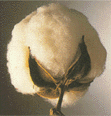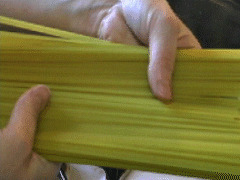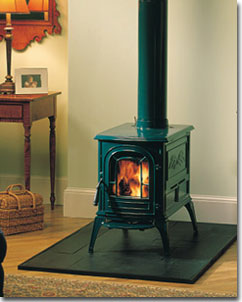Cellulose: What It Is and How It's Used
 Cellulose is a polymer that plants make from glucose. Cotton is mostly cellulose, and so is wood. The hydrogen bonding between the chains is awesome. It's the hydrogen bonding that holds the chains together so strongly that the structure can hold up the tallest trees, and so tightly that even water can't get in. (And thank goodness - otherwise what would your cotton shirt look like in the rain?!!)
Cellulose is a polymer that plants make from glucose. Cotton is mostly cellulose, and so is wood. The hydrogen bonding between the chains is awesome. It's the hydrogen bonding that holds the chains together so strongly that the structure can hold up the tallest trees, and so tightly that even water can't get in. (And thank goodness - otherwise what would your cotton shirt look like in the rain?!!)
|
|
Chains of cellulose are kind of like uncooked spaghetti: extended and lined up next to each other. Imagine these sticks of spaghetti much, much longer, and stuck to each other, too.
|

|
Of course, not only does nature use cellulose for structural strength - so do we, to build houses out of wood. And we can't ignore the paper industry that uses wood pulp to make paper. LOTS of paper.
|
|
Wood gives off enough heat from combustion to use it as fuel, and many folks actually do use wood stoves to heat their homes in the winter. Pictured to the right is a modern wood stove (photo compliments of Vermont Castings).
|

|
What about cotton? There's not much that we can do with cotton in terms of processing it, other than to twist the fibers to make thread or yarn (and then weave it into cloth). Recent developments in the agriculture of cotton include naturally-colored cotton that won't require any dyes at all (but of course it's more expensive!). Non-woven cotton fibers are found in specialty paper, and gives more of a cloth-like feel to the paper.
O.k., so it's those rough and tough hydrogen bonds that give cellulose its strength, but also limit its applications. How could we change the structure of cellulose to increase the number of applications? Any ideas?
Continue on
 Cellulose is a polymer that plants make from glucose. Cotton is mostly cellulose, and so is wood. The hydrogen bonding between the chains is awesome. It's the hydrogen bonding that holds the chains together so strongly that the structure can hold up the tallest trees, and so tightly that even water can't get in. (And thank goodness - otherwise what would your cotton shirt look like in the rain?!!)
Cellulose is a polymer that plants make from glucose. Cotton is mostly cellulose, and so is wood. The hydrogen bonding between the chains is awesome. It's the hydrogen bonding that holds the chains together so strongly that the structure can hold up the tallest trees, and so tightly that even water can't get in. (And thank goodness - otherwise what would your cotton shirt look like in the rain?!!)




